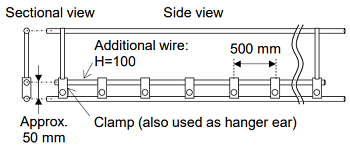8. Compound Catenary for preventing break of contact wires at insulated overlaps
Trains must be stopped when an emergency stop button is pressed or another emergency warning is issued.
If the train stops at insulated overlaps (Air Section (AS) in Japanese) where two overhead contact lines from different power supply systems are laid in parallel, an arc may be generated between the pantograph contact strip and the contact wire and causes a break of the contact wire. Several hardware measures had been proposed to prevent such problems, but all of them had issues such as high cost and difficulty in maintenance.
Therefore, a compound catenary for preventing break of the contact wire (named AS compound catenary) was developed for a simple catenary of conventional lines. With an AS compound catenary, even though the contact wire is extended due to the heat of the arc that is generated between the pantograph contact strip and the contact wire, the contact wire is lowered because of the transmission of the tension from the contact wire to the additional wire. As a result, the contact wire contacts with the pantograph contact strip to extinguish the arc (Fig. 1).
An AS compound catenary has a simple structure in which an additional wire is attached 50 mm above the contact wire by using clamp at intervals of 500 mm (Fig. 2). Since it is possible to measure the diameter of contact wire by an inspection car in the same way as a general catenary, low cost and labor saving for maintenance can be achieved.
It is necessary to evaluate the current collection performance of an AS compound catenary on account of increase of the mass of an AS compound catenary compared to a simple catenary.
As a result of evaluation current collection performance of an AS compound catenary in a commercial line, it was confirmed that excessive contact loss and excessive wear of contact wires were not occurred (Fig. 3).



